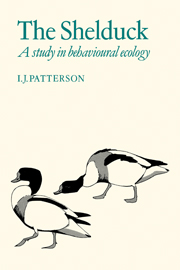Book contents
- Frontmatter
- Contents
- Acknowledgments
- 1 Introduction
- 2 The shelduck
- 3 Gregariousness: the winter flock
- 4 Territories
- 5 Prospecting for nest sites
- 6 Laying and incubation
- 7 Care of the young
- 8 Duckling survival
- 9 Recruitment and the non-territorial flock
- 10 The limitation of shelduck populations
- References
- Subject index
- Author index
2 - The shelduck
Published online by Cambridge University Press: 04 August 2010
- Frontmatter
- Contents
- Acknowledgments
- 1 Introduction
- 2 The shelduck
- 3 Gregariousness: the winter flock
- 4 Territories
- 5 Prospecting for nest sites
- 6 Laying and incubation
- 7 Care of the young
- 8 Duckling survival
- 9 Recruitment and the non-territorial flock
- 10 The limitation of shelduck populations
- References
- Subject index
- Author index
Summary
Taxonomy
Shelducks are intermediate between the true ducks and the geese, although they are usually placed with the ducks in the family Anatidae, where they join the sheldgeese in the tribe Tadornini (Johnsgard, 1961). There are seven species of shelducks: the common or northern shelduck Tadorna tadorna (L.), the ruddy shelduck T. ferruginea (Pallas), the Cape or South African shelduck T. cana (Gmelin), the Australian shelduck or mountain duck T. tadornoides (Jardine & Selby), the New Zealand or paradise shelduck T. varietaga (Gmelin), the radjah shelduck or burdekin duck T. radjah (Garnot) and the crested or Korean shelduck T. cristata (Kuroda) (which may be extinct). All are large brightly coloured ducks with many goose-like features. The lack of a camouflaged female plumage, the persistence of the pair bond and the prolonged parental behaviour shown by the male all resemble the geese, whereas the general morphology, voice and the existence of an eclipse plumage are duck-like. Johnsgard (1978) considered that, like the radjah shelduck, the common shelduck represents a rather isolated offshoot from the rest of the group. Both species are adapted for dabbling and feed chiefly on molluscs and other invertebrates, whereas the rest of the group are principally vegetarian.
The common shelduck was originally called Anas tadorna by Linnaeus in 1758, but has had a variety of other names including Tadorna cornuta (Saunders, 1889) Tadorna vulpanser and Tadorna bellonii (Yarrell, 1843).
- Type
- Chapter
- Information
- The ShelduckA Study in Behavioural Ecology, pp. 5 - 39Publisher: Cambridge University PressPrint publication year: 1982



